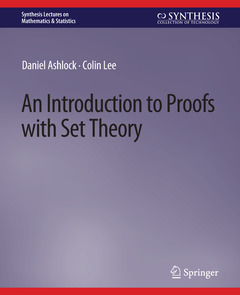An Introduction to Proofs with Set Theory Synthesis Lectures on Mathematics & Statistics Series
Langue : Anglais
Auteurs : Ashlock Daniel, Lee Colin

This text is intended as an introduction to mathematical proofs for students. It is distilled from the lecture notes for a course focused on set theory subject matter as a means of teaching proofs. Chapter 1 contains an introduction and provides a brief summary of some background material students may be unfamiliar with. Chapters 2 and 3 introduce the basics of logic for students not yet familiar with these topics. Included is material on Boolean logic, propositions and predicates, logical operations, truth tables, tautologies and contradictions, rules of inference and logical arguments. Chapter 4 introduces mathematical proofs, including proof conventions, direct proofs, proof-by-contradiction, and proof-by-contraposition. Chapter 5 introduces the basics of naive set theory, including Venn diagrams and operations on sets. Chapter 6 introduces mathematical induction and recurrence relations. Chapter 7 introduces set-theoretic functions and covers injective, surjective, and bijective functions, as well as permutations. Chapter 8 covers the fundamental properties of the integers including primes, unique factorization, and Euclid's algorithm. Chapter 9 is an introduction to combinatorics; topics included are combinatorial proofs, binomial and multinomial coefficients, the Inclusion-Exclusion principle, and counting the number of surjective functions between finite sets. Chapter 10 introduces relations and covers equivalence relations and partial orders. Chapter 11 covers number bases, number systems, and operations. Chapter 12 covers cardinality, including basic results on countable and uncountable infinities, and introduces cardinal numbers. Chapter 13 expands on partial orders and introduces ordinal numbers. Chapter 14 examines the paradoxes of naive set theory and introduces and discusses axiomatic set theory. This chapter also includes Cantor's Paradox, Russel's Paradox, a discussion of axiomatic theories, an exposition on Zermelo?Fraenkel Set Theory with the Axiom of Choice, and a brief explanation of Gödel's Incompleteness Theorems.
Preface.- Acknowledgments.- Introduction and Review of Background Material.- Boolean Logic and Truth (Values).- Quantified Predicates, Rules of Inference, and Arguments.- Mathematical Proofs.- Intuitive Set Theory.- Mathematical Induction.- Functions.- The Integers and Beyond.- Counting Things.- Relations.- Number Bases, Number Systems, and Operations.- Many Infinities: Cardinal Numbers.- Many Infinities: Ordinal Numbers.- Paradoxes and Axiomatic Set Theory.- Bibliography.- Authors' Biographies.- Index.
Daniel Ashlock was awarded a Ph.D. in Mathematics from the California Institute of Technology. He has taught more than 50 different classes from abstract algebra to bioinformatics but enjoys set theory because it is the first time most students meet abstract mathematics. Dr. Ashlock is a Professor of Mathematics at the University of Guelph where he uses mathematics to help biologists with their research as well as continuing his own work in how to represent information to make it easier to understand and easier to work with on a computer. Dr. Ashlock is a Senior Member of the IEEE and has chaired technical committees in both bioinformatics and games, demonstrating the broad usefulness of an education in mathematics.Colin Lee received his Ph.D. in Applied Mathematics from the University of Guelph. While at the University of Guelph he taught set theory both initially as a teaching assistant for Dr. Daniel Ashlock, as well as subsequently as a lecturer in his own right. Since graduating he has been sporadically involved in mathematical research, education, and tutoring while pursuing a variety of endeavours including consulting, programming, commercial art, and authoring mystery and horror fiction.
Date de parution : 06-2020
Ouvrage de 233 p.
19.1x23.5 cm
Thème d’An Introduction to Proofs with Set Theory :
© 2024 LAVOISIER S.A.S.
